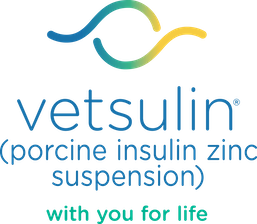

Nutrition for Dogs With Diabetes
Read More About Monitoring & Controlling Canine Diabetes
A Factor in Influencing Glycemic Control
Insulin therapy provides the mainstay of management for most patients, but management of other factors such as diet and exercise can also help.
Dietary Control
Since diabetes in dogs most closely resembles Type 1 diabetes in people, dietary management will not remove the requirement for insulin. The aim of dietary change is to improve glycemic regulation.
A diet must provide all the nutritional needs of patients and should minimize postprandial fluctuation in glucose concentrations.
The essential features of the diet should be:
- Consistent from day-to-day, in type, volume and timing, to prevent unnecessary alterations in insulin requirement.
- High in complex carbohydrates so that glucose is released in a steady fashion from the gut.
- Given so that glucose absorption from the gut coincides with peak action of administered insulin. For dogs that receive Vetsulin once daily, 2/3 of the daily ration should be fed prior to the injection with the remainder fed about 10-12 hours later. For dogs that receive Vetsulin twice daily, 1/2 of the daily ration should be fed prior to each meal, 12 hours apart.
- Of the correct caloric value to take diabetes weight to optimal weight.
- Fat-restricted.
The ideal diet for a patient with diabetes should contain restricted fat, increased complex carbohydrates, and increased fiber and should be chosen to suit both the owner and the dog. There are a number of prescription diets that have been specially formulated for the management of diabetes.
These can be particularly useful for achieving weight loss in obese patients. However, most dogs with diabetes can be stabilized on a carefully controlled program using their normal diet. Stabilization on a non-prescription diet is much easier if a complete, moist food is being fed.
Clean drinking water should be available at all times. A reduction in excessive water consumption indicates successful management of diabetes mellitus.
Importance of an Ideal Body Weight
In dogs that are underweight or overweight, it is desirable that the ideal body weight is reached by gradual weight gain or loss, respectively.
In underweight animals, very calorically restricted diets should be avoided, especially those that are high in soluble carbohydrates.
Obesity contributes to insulin resistance. Overweight dogs should lose weight in a gradual, controlled fashion. Weight loss in obese animals decreases the insulin requirement. Diets designed to promote weight loss are high-fiber diets and are suitable for feeding to dogs with diabetes.
The following pet food companies produce balanced diets formulated for dogs with diabetes. For more information, click on each company name to reach its website.
For specific information about dietary control, see the Feeding Schedule for dogs.
Resources to Help Clients Monitor Care
Help Your Practice Manage Diabetes Mellitus
View and download resources and tools that will assist your hospital, inform your team, and help with clients.

Blood Glucose Curve Generator
Create a blood glucose curve to monitor and evaluate diabetes treatments.

Client Discharge Form
Create a customized, printable form for clients about their new diagnosis.

Diabetes Resources
Access online tools and more to support staff and pet parents.
No items to show.
Read More About Monitoring &Controlling Canine Diabetes
Important Safety Information:
Vetsulin® should not be used in dogs known to have a systemic allergy to pork or pork products. Vetsulin is contraindicated during periods of hypoglycemia. Keep out of reach of children. As with all insulin products, careful patient monitoring for hypoglycemia and hyperglycemia is essential to attain and maintain adequate glycemic control and prevent associated complications. Overdosage can result in profound hypoglycemia and death. The safety and effectiveness of Vetsulin in puppies, breeding, pregnant, and lactating dogs has not been evaluated. See package insert for full information regarding contraindications, warnings, and precautions.
References:
1. Martin GJ, Rand JS. Pharmacology of a 40 IU/ml porcine lente insulin preparation in diabetic cats: findings during the first week and after 5 or 9 weeks of therapy. J Feline Med Surg. 2001;3(1):23–30. 2. Vetsulin® (porcine insulin zinc suspension) [Freedom of Information Summary]. Millsboro, DE: Intervet Inc.; 2008. 3. Data on file, Merck Animal Health. 4. Graham PA, Nash AS, McKellar QA. Pharmacokinetics of porcine insulin zinc suspension in diabetic dogs. J Small Anim Pract. 1997;38(10):434–438. 5. Martin GJ, Rand JS. Pharmacokinetic and Pharmacodynamic Study of Caninsulin in Cats with Diabetes Mellitus. 2000: Internal Study Report. 6. Feldman EC, Nelson RW. Canine and Feline Endocrinology and Reproduction. 3rd ed. St. Louis, MO: Saunders; 2004:539–579. 7. Tennant B, ed. BSAVA Small Animal Formulary. 4th ed. Gloucestershire, UK: British Small Animal Veterinary Association; 2002. 8. Feldman EC, Nelson RW. Canine and Feline Endocrinology and Reproduction. 3rd ed. St. Louis, MO: Saunders; 2004:486–538. 9. Reusch C. Feline diabetes mellitus. In: Ettinger SJ, Feldman EC, eds. Textbook of Veterinary Internal Medicine. 7th ed. St. Louis, MO: Saunders; 2010:1796–1816. 10. Nelson RW. Canine diabetes mellitus. In: Ettinger SJ, Feldman EC, eds. Textbook of Veterinary Internal Medicine. 7th ed. St. Louis, MO: Saunders; 2010:1782–1796. 11. Burgaud S, Riant S, Piau N. Comparative laboratory evaluation of dose delivery using a veterinary insulin pen. In: Proceedings of the WSAVA/FECAVA/BSAVA congress; 12–15 April 2012; Birmingham, UK. Abstract 121. 12. Burgaud S, Guillot R, Harnois-Milon G. Clinical evaluation of a veterinary insulin pen in diabetic dogs. In: Proceedings of the WSAVA/ FECAVA/BSAVA congress; 12–15 April 2012; Birmingham, UK. Abstract 122. 13. Burgaud S, Guillot R, Harnois-Milon G. Clinical evaluation of a veterinary insulin pen in diabetic cats. In: Proceedings of the WSAVA/FECAVA/BSAVA congress; 12–15 April 2012; Birmingham, UK. Abstract 45. 14. Davison LJ, Walding B, Herrtage ME, Catchpole B. Anti-insulin antibodies in diabetic dogs before and after treatment with different insulin preparations. J Vet Intern Med. 2008;22:1317-1325. 15. Banfield State of Pet Health 2016 Report. p 12-13.
